Imagine this: you are one of the most influential traders in Jaipur, a beautiful city rich in history and culture, and you are known all around India for your bartering skills.
However, being successful isn’t enough; you want the privilege of receiving an invitation to the Maharaja’s court, which will only happen when you receive two seals of excellence – this is the premise of the fast-paced card game Jaipur.
Have you been suitably drawn in by this captivating story, just as I was when I first heard it?
If not, I know you will be soon; Jaipur is a card game worth getting excited about. It was released in 2009, has been nominated for numerous awards, and continues to be a popular choice at my family’s weekly board game night thanks to its mixture of risk, tactics, and luck.
In this Jaipur board game guide, I will share with you everything I know about how to play and win. I’ll also include some information about various tactics you can use and how to create a strategy. Sounds good? Then let’s get started!
Jaipur: A Quick Overview
- Players: 2
- Recommended age: 12+
- Playing time: 30 minutes
Jaipur is a card game that’s all about trading. If you’ve ever found yourself in a situation where you’ve negotiated a lower price for an item you wanted to buy, you’ll be able to get to grips with Jaipur in no time. I’m not a natural negotiator, but playing this game has certainly improved my skills.
Cards in Jaipur represent different goods you can buy or sell during your turn. When you sell goods, you earn rupees – all you have to do is make more money than your opponent in each game round to emerge triumphant.
Aim of the Game
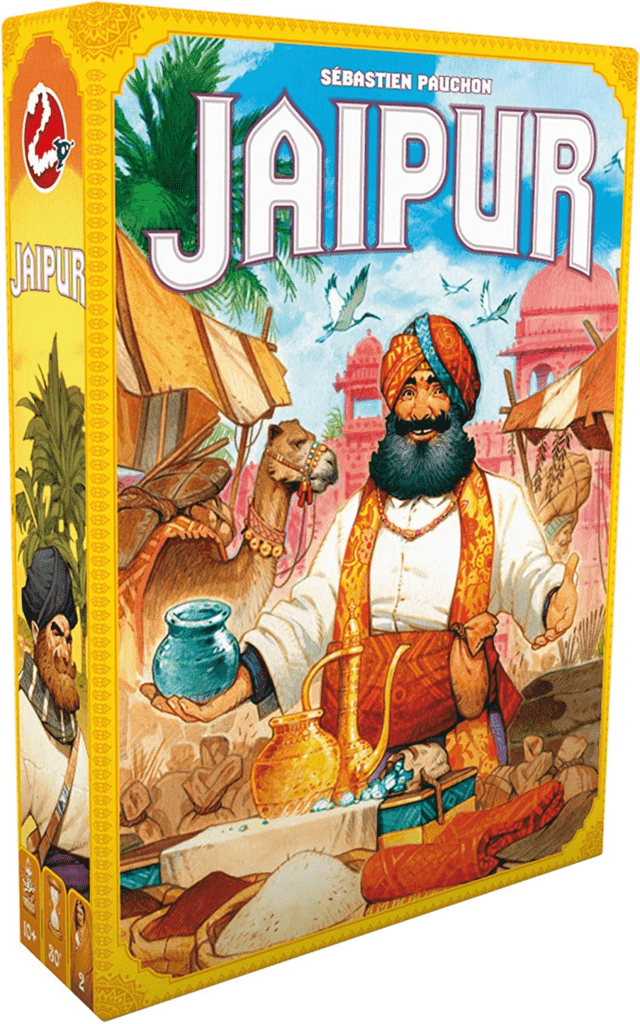
The aim of Jaipur is to win two seals of excellence by earning more money through trading goods than your opponent. If you achieve this, you can become Maharaja’s personal trader, a much sought-after and prestigious position.
How to Play
Whether you consider yourself a slick negotiator or a total newbie to the world of trade, I’ll have you winning Jaipur in no time – follow my advice below.
Setup
You’ll have to set up a little before you can start playing. The good news is that this should take little time because Jaipur is a card game!
First, you need to take three camel cards and put them face-up between all players. Once this has been done, shuffle the cards that are left. I’d recommend spending a minute or so doing this, especially when you’ve played before, to make sure the cards are totally different.
The next step is to deal five cards to each person in the game. You can leave the leftover cards face-down in a pile; you’ll use this as a draw deck later.
Now, you need to take the two top cards from the deck and put them face-up beside the camels; this completes the market (needless to say, you can’t have a trading game without a market!).
Before the game begins, each player must remove any camel cards from their hands and place them face-up in a stack in front of them. These cards are your herd – take good care of them!
For the next stage of setting up, it’s time to turn your attention to the tokens. They must be sorted into groups based on the type of goods they represent. Make a pile for each goods type, putting them in descending order based on value, and spread out each group, so the tokens’ values are visible to all players.
After this, sort the bonus tokens in the same way. Once you’ve organized them by type, shuffle each group and form three piles that are not spread out.
Place the camel token beside the bonus tokens, and set up the tokens according to the diagram in the instructions booklet.
The final step is to place the three Seals of Excellence where all players can see them.
Once you’ve chosen a starting player, you’re ready to play!
Gameplay
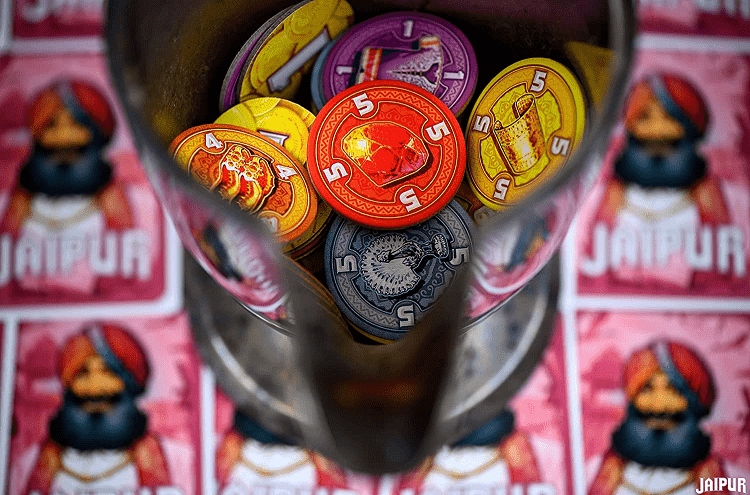
Now it’s time for my favorite part: finally playing the game. I picked up the rules of Jaipur pretty quickly, and I’m sure you will too.
Taking a Turn
When it’s your turn, you can do one of the following things: either take or sell cards. I can’t stress how vital this is; you can never do both!
When you have finished your turn, your opponent takes over.
Take Cards
When you decide to take cards, you then must choose one of the following options:
- Take one single good
- Take several goods
- Take all the camels
Option one requires you to take one goods card from the market and replace it with the top card from the deck.
Option two requires you to take all the goods cards you want and exchange them for the same number of cards. One thing I should have realized when I first started playing Jaipur is that the goods cards you take can be of different types; you can choose any. Likewise, the cards you return can be goods, camels, or any combination.
The third option allows you to take all the camels from the market and incorporate them into your herd. After this, you must replace the cards you took by drawing from the deck.
Take note – players can have up to seven cards at the end of their turn.
Sell Cards
So you’ve decided to sell cards instead of taking them. To do this, choose one type of goods and discard as many of that type of card as you’d like. These discarded cards count as “sales”; each sale earns goods tokens and a bonus if the sale is big enough!
You should carry out a sale in the three following steps:
- Sell as many cards as you’d like, putting them face-up in the discard pile.
- Take the same number of goods tokens, starting with the highest values, and stack them in front of you.
- You can take the corresponding bonus token if you’ve sold three or more cards.
There are also some restrictions you should be aware of during a sale. When selling the three most expensive goods (gold, silver, and diamond), the sale must include at least two cards. It’s easy to forget this rule (my friends and I have done so before), but it plays an integral part in the game.
Remember, you can only sell one type of goods each round. Unfortunately, you can’t mix and match.
End of a Round

A round ends straight away if:
- When trying to fill the market, no cards are left in the draw pile.
- Three types of goods tokens are depleted.
Once a round has finished, you’ll need to work out the scoring. The player who has the most camels receives the matching camel token worth five rupees.
Players must then add up their tokens to determine who has more money. If you’re playing with children, I’d recommend making piles of ten rupees, so they are easier to count; my young niece found this trick helpful.
The most affluent trader takes a Seal of Excellence. However, if a tie occurs, the player who possesses the most bonus tokens takes the seal. If this doesn’t break the tie, the person with the most goods tokens takes the seal.
New Round
If neither player has earned two Seals of Excellence yet, it’s time to set up the game as you did before and play another round. The person who lost the previous round begins the new one.
End of the Game
As soon as a player has two Seals of Excellence, the game ends immediately. That person is the winner and is appointed the Maharaja’s personal trader.
Don’t Forget!

Here are some handy reminders and notes about the game.
- You can either take goods or camels from the market; never both.
- When you take camels from the market, you must take all of them.
- When you make an exchange, the surrendered cards can be any mix of camels and goods; the same goods can’t be surrendered and taken at the market, and you’re not allowed to exchange only one card from your hand for one from the market.
- If you have the same camels as your opponent at the end of the round, neither of you gets the camel token (worth five rupees).
- When fewer tokens are available than cards during a sale, you still receive the bonus token for the number of cards you sold.
- You don’t have to let your opponent know how many camels you have.
- Camels don’t count toward the seven-card limit.
Advice for after Your First Game
I’ve added this section to give you some helpful advice, but it’s best to come back and read it once you’ve played your first game.
The first thing to be aware of is that using camels is a balancing act; if you have none and want to take a lot of cards but your hand is empty, this is a big problem. Conversely, if you take lots of camels, you risk creating a very profitable market for your fellow player.
I’d recommend only taking a large group of camels once your opponent already has seven cards in their hand because, even if the market is attractive, they probably will only be able to take some of the cards they want.
When you’ve played Jaipur long enough, you’ll probably develop an instinct for when good cards will likely turn up. If you sense this is about to happen, it’s a good idea to make an exchange that fills the market with camels; doing so forces your opponent to open up the game for you.
As you’ll know by now, there are three primary sources of income: the big sale bonuses, the first tokens in each set, and the three expensive goods. All three are equally important.
Make sure your opponent doesn’t grab all the gold, diamonds, and silver; try to sell before them if you can, and make one or two massive sales during the game.
How Many Pieces are There in Jaipur?
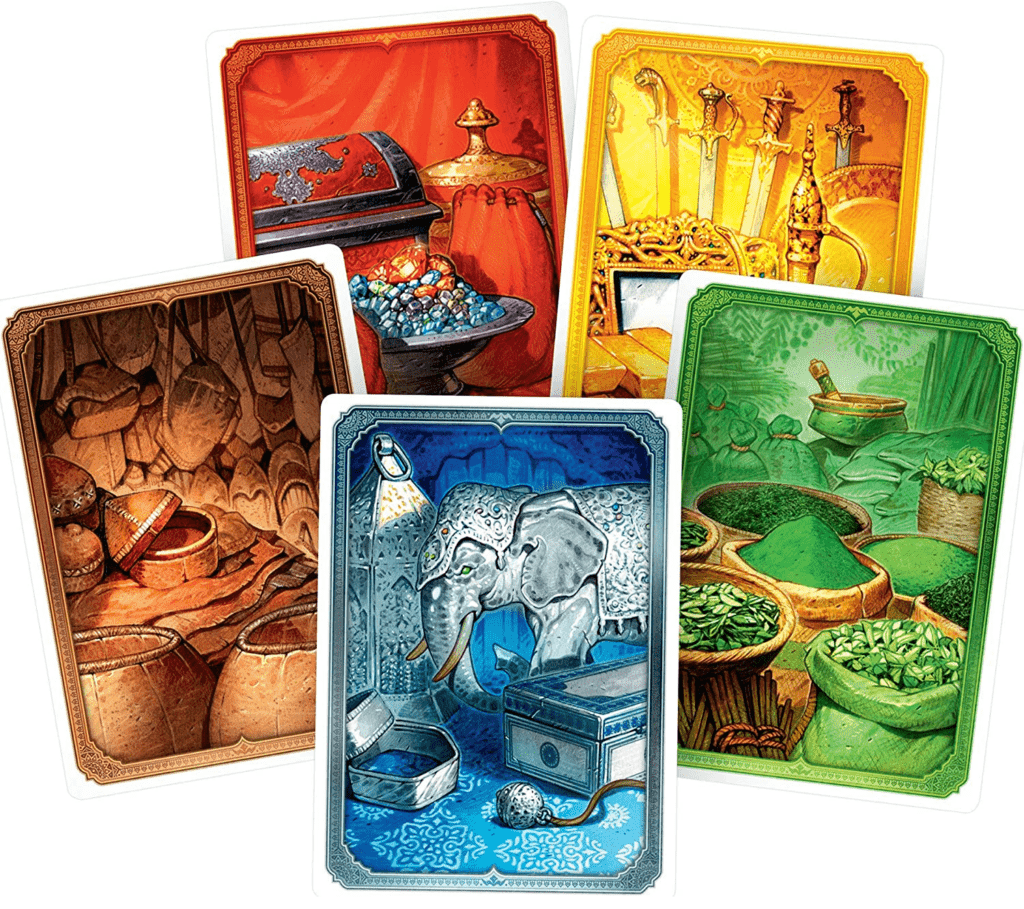
Jaipur contains the following components.
- 6x diamond cards
- 6x gold cards
- 6x silver cards
- 8x cloth cards
- 8x spice cards
- 10x leather cards
- 11x camel cards
- 38x goods tokens
- 3x Seals of Excellence
- 1x camel token
- 18x bonus tokens
Alternatives to Jaipur
If you enjoyed Jaipur, I’d recommend checking out the following games.
Flesh and Blood
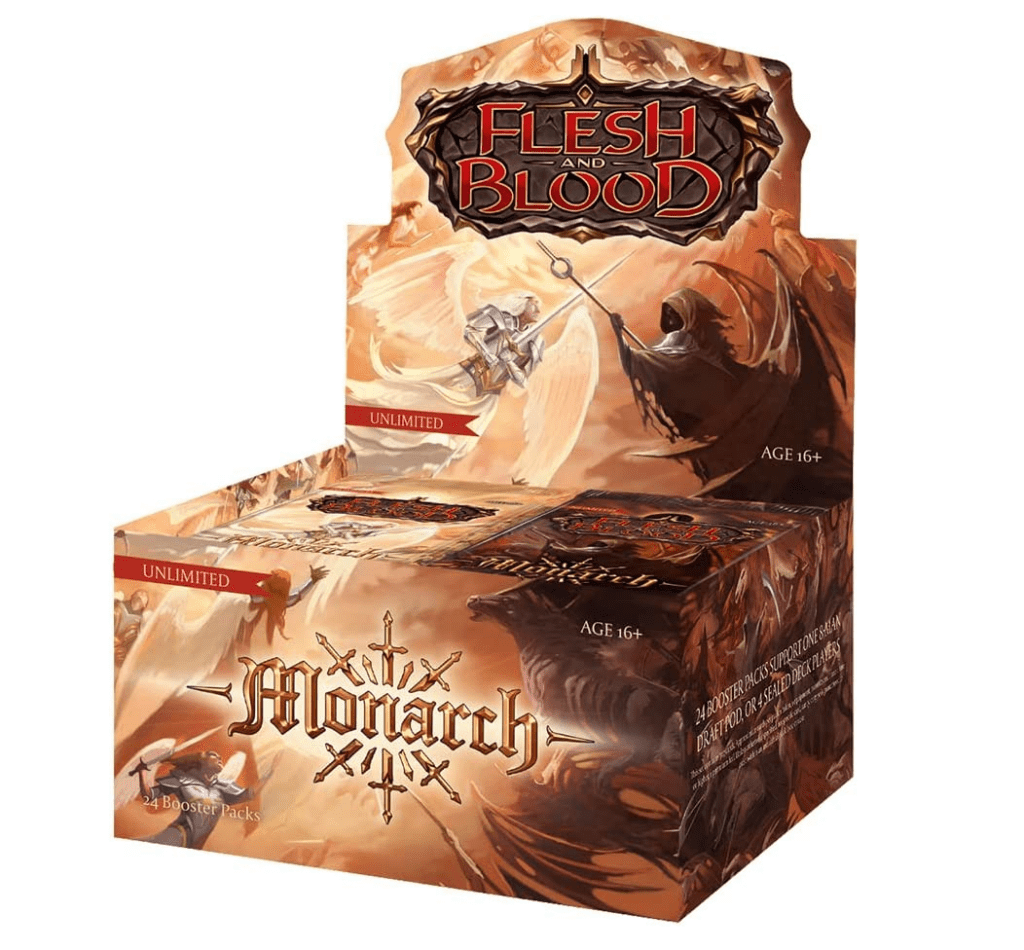
Flesh and Blood is an up-and-coming card trading game that I suspect may one day reach a similar level of popularity to the big three: Pokemon, Magic, and YuGiOh.
You’ll take on the role of a Hero fighting against another Hero in one-on-one combat, using unique abilities, armor, and weapons. This game has even caught the eye of a few pro-competitive trading card game players.
- Players – 2
- Recommended age – 14+
- Playing time – 10-50 mins
Find out more about Flesh and Blood in our game guide.
Fungi

Fungi is a little bit like the traditional card game Rummy. The aim is to match high-scoring mushroom cards with three or more of the same kind and put them in your “pan” to earn points.
It might sound simple, but when you play Fungi, you’ll soon find out there are more steps involved than you’d expect. I guarantee you’ll love it if you’re a card game fan.
- Players – 2
- Recommended age – 10+
- Playing time – 30 mins
For more information, check out our Fungi card game guide.
Illusion
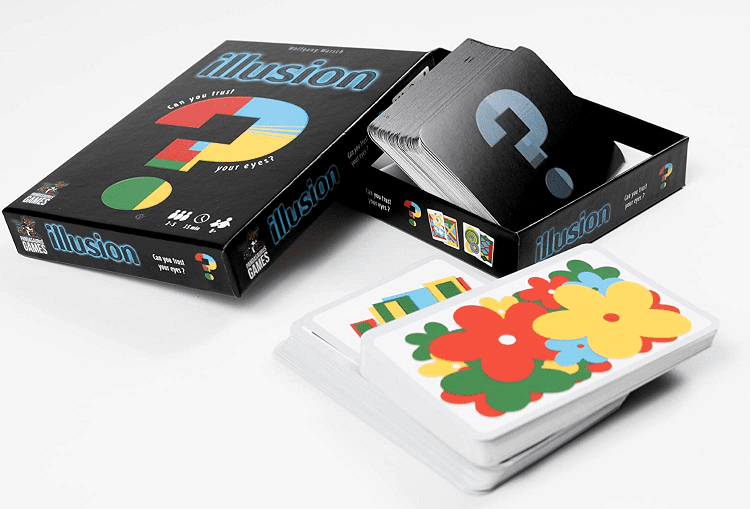
Illusion is a unique card game compared to the others I’ve discussed in this guide; rather than focusing on trading, it asks players to look at various optical illusions and order the cards based on color distribution. It’s one of my favorite card games because you can play with friends, and it’s always fun calling their bluff!
- Players – 2-5
- Recommended age – 8+
- Playing time – 15 minutes
Find important information about the game in our Illusion card game guide.
Cards Against Humanity
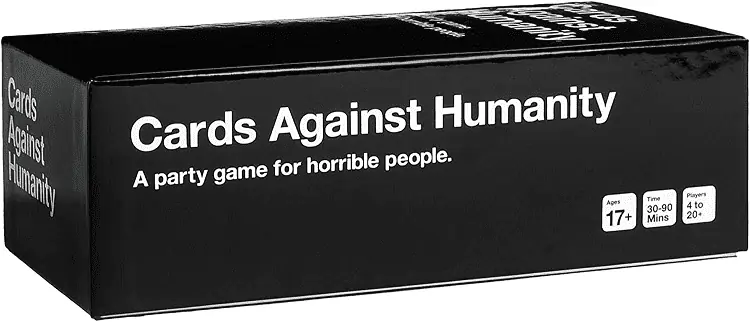
I don’t know where you’ve been the last few years if you haven’t already heard of Cards Against Humanity. It is the funniest, most outrageous card game in existence.
The aim? Come up with the best card combination and create hilarious (often controversial) statements with your friends. Plus, there are tons of expansion packs, so the game never gets old!
- Players – 4-30
- Recommended age – 17+
- Playing time – 30 minutes
Look at our ultimate Cards Against Humanity game guide to learn more!
Frequently Asked Questions
Question: Is Jaipur a Good Game?
Answer: The thing I like about Jaipur is that it’s a speedy card game – perfect for playing on the go. I’ve had this in my game collection for slightly under a year, and I still regularly reach for it, so I’d say it’s a good card game.
Question: How many Cards are there in Jaipur the Game?
Answer: In total, there are 55 cards in the game.
Question: Can You Play Jaipur Solo?
Answer: It isn’t possible to play Jaipur solo because it is a trading game; consequently, you must play against an opponent. However, if you’re looking for a game you can play on your own, check out our guide to the best solo games.
Question: Does Jaipur Involve Strategy?
Answer: You can use some strategies to get ahead in Jaipur, which I outlined earlier in the “advice for after your first game” section. It is a quick and reasonably easy game; read this guide to the best strategy board games if you want more strategy.
In Summary
Jaipur is the perfect card game for people who lead busy lives and don’t always have a lot of time to spare. It’s quick to set up, quick to learn, and easy to play, with the potential for a small amount of strategic gameplay.
If you’re used to more complex board games, this isn’t the game for you. But if you’re looking for a card game you can play in half an hour or less, I recommend Jaipur.
Recommended reads:
- A Guide to Board Game Cafes
- Patchwork Board Game Guide
- Dominion Board Game Guide
- Best Horror Board Games Guide
- Stratego Pieces Explained – Must-Know Facts - February 28, 2023
- Wahoo Board Game Guide – AKA Aggravation Guide - February 22, 2023
- Pokemon Monopoly Guide - February 22, 2023

